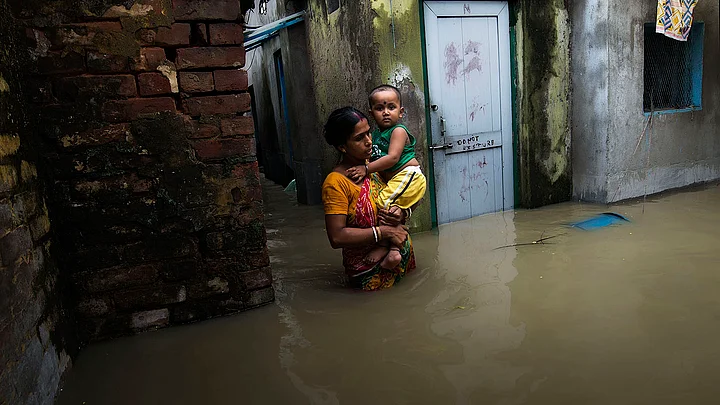Rising sea levels, disappearing lands and droughts in once-fertile regions: these increasingly common climate change phenomena devastate the lives of people who lie vulnerable in their wake. The human faces of climate change in India include, to name a few, the elderly who can’t escape the floods’ rushing waters, the agrarian women who, because of gender mores, feed their husbands and children with their dwindling food stores rather than themselves, and the girls who must now walk miles, rather than meters, in hopes that water might still run in a distant stream.
Those most severely impacted by climate change’s vicissitudes, the poor, live quietly with their struggles. The media barely do justice to the ravages these people face. Often, a passing reference to a World Health Organization revelation that children, women, the elderly and the poor will be hit hardest by climate change is the most “human” the news will get. Or reports of a tragic drought’s death tolls splash across the television for a few days, only to be quickly replaced by other breaking news.
This dearth of sustained, in-depth reporting isn’t necessarily journalists’ fault: faced with tight budgets and a readership that must be pleased, climate change stories – especially those which put a human face on suffering or go beyond the easy-to- spot problems of everyday traffic congestion and air pollution – are not the focus of most publishing houses, nor of the readership they serve.
But India is not without its climate change activists – its “environmental warriors,” so to speak. Joydeep Mukherjee, an award-winning Kolkata-based environmental photographer, and his assistant Jhinku Banerjee, capture the human face of India’s climate crisis. Joydeep’s photographs reveal climate change consequences that go beyond the faceless statistics and minimalist news reports. His photographs touch the hearts of those who care to look.
An environment in crisis is something Joydeep experiences first hand. His neighbourhood floods whenever the Ganges overflows its banks. This happens with increasing regularity, he explains, leaving inhabitants scrambling to protect their loved ones and valuables, and forging chest-deep waters along, what a day before, was their street. Jhinku’s neighbourhood is also prone to flooding. She describes the skin rashes she and her neighbours get wading through the dirty waters. “I see the animals suffering too, and my heart aches,” she says.
Joydeep photographs a variety of subjects, but women and children are increasingly the focus of his work. “Housewives in my area are often the ones at home when it floods, so they fight the waters to take care of their children,” he explains – a situation that several of his photographs capture with heartrending clarity.
In one photo, a woman, water up to her breasts, clutches her baby in her arms and looks directly into the camera’s lens. She stands in front of her now-uninhabitable home. There is no longer a stove on which to cook her family’s food, nowhere left to sit or sleep. Sanitation concerns stand second in importance only to present survival: those who surmount the floodwaters’ immediate threat face the pursuant dangers of food scarcity and disease, carried in the untreated and often contaminated waters.
Joydeep also captures the plight of the vulnerable outside of his home surroundings. Between 2009 and 2011, on a series of trips to southern West Bengal, he photographed women gathering water – a chore traditionally seen as “women’s work” in India’s agrarian and rural households – in an otherwise scorched land. The land is sere. Sun-baked terrain extends outwards from where three sari-draped figures walk, holding their water jugs with care as they navigate the cracked soil. This image conveys the life-threatening impact the changing environment has on people who don’t have the financial or physical means to escape its expanding jaws. This is climate change, starkly revealed.
Speaking of people who cannot escape environmental change’s grasp, one of Joydeep’s most resonating images features a physically impaired man who has lost control of his wheelchair in a flood. He is helped along by a stranger who will not let him drown. This photograph testifies to both the potential ferocity of an unbalanced natural world, as well as the human spirit and capacity for compassion under fire.
For those of us born in luckier regions, or with the financial power to stave off our immediate experience of climate change with air conditioning, access to purified tap water and store-bought or imported foods, it’s easy to get lost in the small concerns of our daily lives. But climate change, though harder for us to see here and now, is having immediate, painful and life-terminating consequences for our world’s – and certainly India’s – largest demographic: the poor. Joydeep Mukherjee, with Jhinku Banerjee, are among India’s “environmental warriors” – visually documenting climate crises in the hopes that seeing, may actually mean believing.
Nicolette Little is a Canadian researcher and writer, currently based in New Delhi, India. She met Joydeep Mukherjee and Jhinku Banerjee while exploring climate change’s gender dimensions in Indian media. Visit her website.
